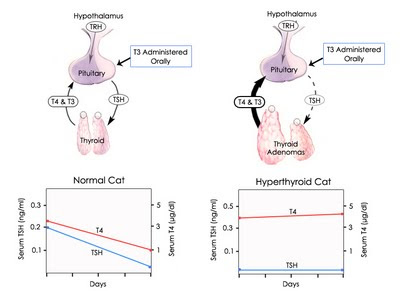What testing protocol do you use? Can you explain how you interprete the test results?
My Response:
Liothyronine sodium is the L-isomer of triiodothyronine (T3). I have always used tablets that contain 25 μg. The common trade name for L-T3 is Cytomel (Figure 1).
Protocol for T3 suppression test in cats
The test protocol that I developed over 20 years ago and still use is as follows (1):
 |
| Figure 1: Cytomel |
- One day 1, draw a blood sample is drawn for determination of baseline serum concentrations of total T4 and T3. This serum sample is not yet submitted to the laboratory but kept refrigerated (or frozen) until day 4.
- Owners are instructed to give 7 doses of a T3 pill (liothyronine sodium; Cytomel) to their cat, beginning on the following morning.
- On day 2 and 3, the owners administer the liothyronine at a dosage of 25 µg every 8 hours for 2 days (6 doses).
- On the morning of day 4, a seventh 25-µg dose of liothyronine is given and the cat returned to the veterinary clinic within 2 to 4 hours.
- The veterinarian again draws a blood sample for serum T4 and T3 determinations.
- Both the basal (day 1) and post-liothyronine (day 4) serum samples are submitted to the laboratory together to eliminate the effect of between assay variation in hormone concentrations.
 |
| Figure 2: T3 suppression tests in normal cats (left) & cats with hyperthyroidism (right) |
Regarding interpretation of T3 suppression test results, I find that the absolute serum T4 concentration after liothyronine administration is the best means of distinguishing hyperthyroid cats from normal cats or cats with nonthyroidal disease (1-5).
Cats with hyperthyroidism have post-liothyronine serum T4 values greater than 20 nmol/L (greater than 1.5 μg/dl), whereas normal cats and cats with nonthyroidal disease have T4 values less than 20 nmol/L (Figure 2). There may be a great deal of overlap of the per cent decrease in serum T4 concentrations after liothyronine administration between the three groups of cats, but suppression of 50 per cent or more only occurs in cats without hyperthyroidism.
Serum T3 concentrations, as part of the T3 suppression test, are not useful in the diagnosis of hyperthyroidism per se. However, these basal and post-liothyronine serum T3 determinations can be used to monitor owner compliance with giving the drug. If inadequate T4 suppression is found, but serum T3 values do not increase after treatment with liothyronine, problems with owner compliance should be suspected and the test result considered questionable.
Disadvantages of the T3 suppression test
Overall, the T3 suppression test is very useful for diagnosis of mild hyperthyroidism in cats, but the test does come with disadvantages:
- T3 suppression testing is a relatively long test (3 days)
- Owners are required to give multiple doses of liothyronine
- Cats must swallow the tablets if the test is going to be meaningful.
- If the liothyronine is not administered properly or the cat does not swallow the liothyronine tablet, circulating T3 concentrations will not rise to decrease pituitary TSH secretion (Figure 2), and the serum T4 value will not be suppressed, even if the pituitary-thyroid axis is normal. Failure of a cat to ingest the liothyronine could result in a false-positive diagnosis of hyperthyroidism in a normal cat or cat with nonthyroidal disease.
References:
- Peterson ME, Graves TK, Gamble DA: Triiodothyronine (T3) suppression test. An aid in the diagnosis of mild hyperthyroidism in cats. Journal of Veterinary Internal Medicine 1990;4:233-238.
- Peterson ME. Diagnostic tests for hyperthyroidism in cats. Clinical Techniques in Small Animal Practice 2006;21:2-9.
- Peterson ME: Diagnostic testing for feline hyper- and hypothyroidism. Proceedings of the 2011 American College of Veterinary Internal Medicine (ACVIM) Forum. pp. 95-97, 2011
- Peterson ME: Hyperthyroidism in cats, In: Rand, J (ed), Clinical Endocrinology of Companion Animals. New York, Wiley-Blackwell, in press.
- Mooney CT, Peterson ME: Feline hyperthyroidism, In: Mooney CT, Peterson ME (eds), Manual of Canine and Feline Endocrinology (Fourth Ed), Quedgeley, Gloucester, British Small Animal Veterinary Association, 2012; in press.

No comments:
Post a Comment